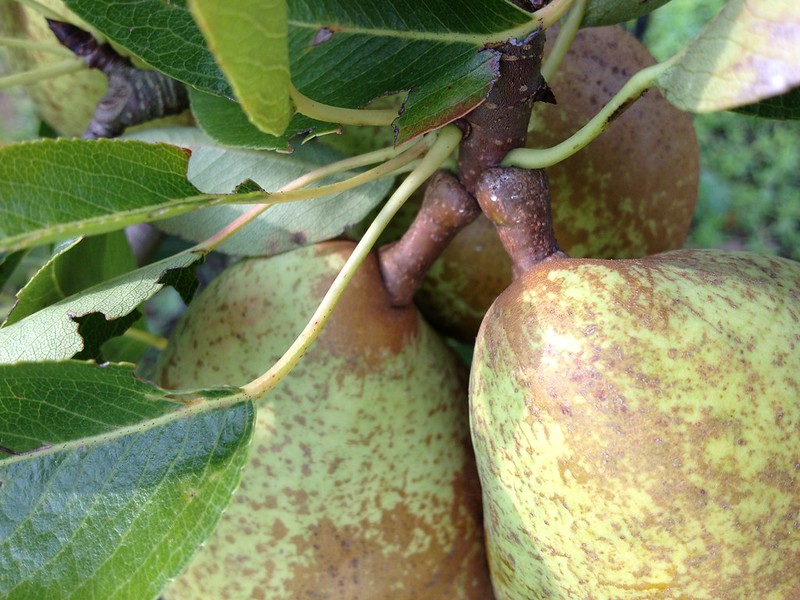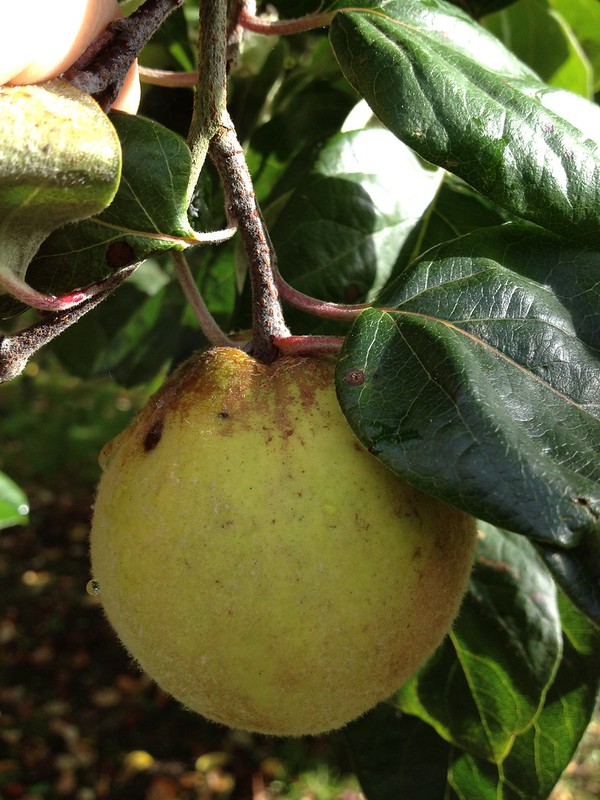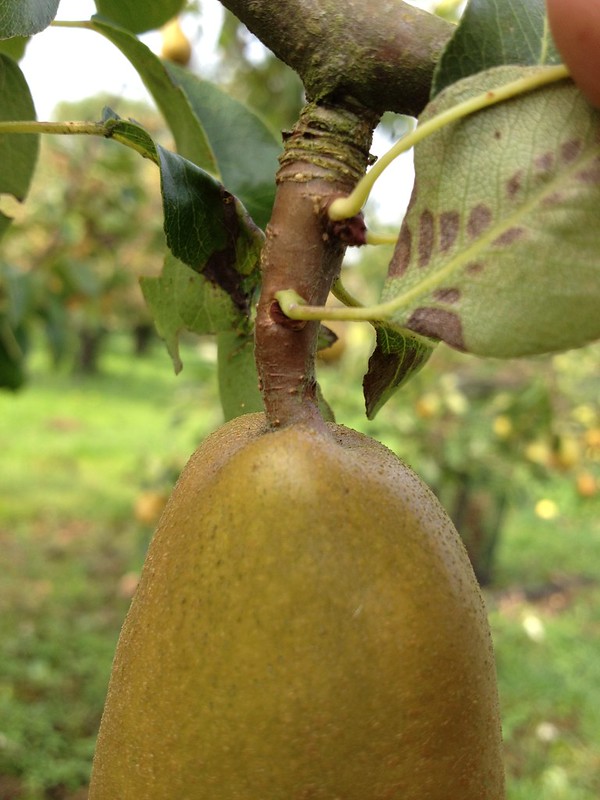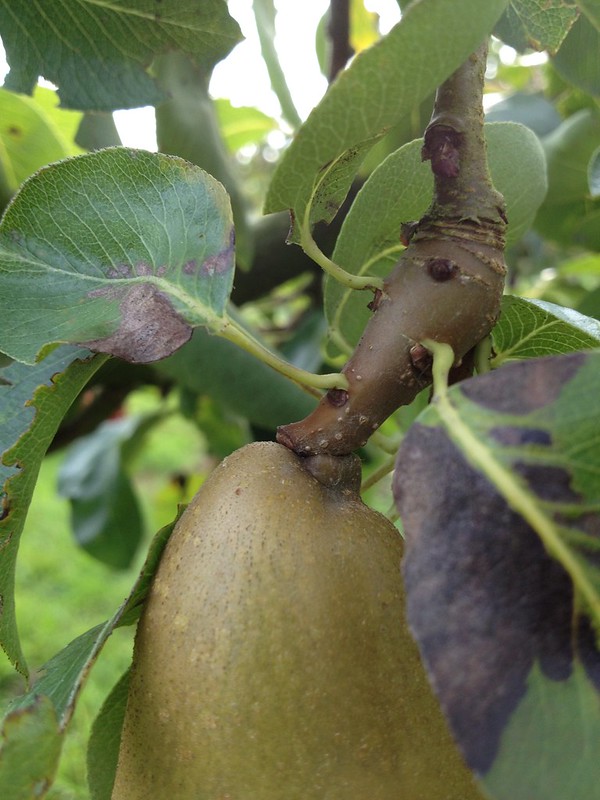My first full day in the team and we were all working together fruit picking in preparation for the ‘Wisley Taste of Autumn Festival’ that will take place in mid-October. A number of colleagues from across the Society and numerous volunteers joined us, in addition to the regular Fruit Department volunteers and the fruit pickers hired for the season.
The day could not but start with some training in the use of picking ladders. They have three legs, and come in two types: we have Welsh ones, that are good for picking in the orchard, with a spike at the bottom of one leg to fix them in the ground and that finishing in a triangular point which is easier to place within the tree canopy, and Japanese ones that are more lightweight, have an extendable leg for uneven ground and terminate in a platform.
 |
| Welsh style ladder |
 |
| Japanese style ladder |
How to use a ladder safely
1. Check that the ladder is fit for use, without broken or damaged parts, frayed cord etc.
2. Open the ladder, pointing to the centre of the tree that is being picked
3. Ensure the ladder is stable on the ground
4. Always keep three points of contact between the body and the ladder, facing it at all time
5. Never climb to the last two steps (usually labelled)
6. Do not overextend to the sides, keep within arm reach from the centre
7. Never leave the ladder open when finished using it
8. Place out of the way between trees, with the steps up (in case of frost in winter)
We picked: apples (there are 450 cultivars only of dessert apples, then there's the 'cookers'), pears and quinces.
It was my first time picking professionally, and realised that the techniques to pick each type of fruit vary.
Apples tend to come off the plant rather easily, with a gentle twist in your cupped hand, while lifting towards the plant (not pulling away from it). However, much depends on the cultivar, and the shape of the stalk. One has to be careful, as sometimes short-stalked apples may be very close to next year’s fruiting buds, damaging which would of course compromise next year’s floriferousness and size of crop.
Pears seem to be trickier to remove as they hang on tighter to the tree, and I found it is useful to keep your index finger on the peduncle while twisting them gently clockwise, then anticlockwise. Sometimes, however, depending again on the pear cultivar and how the individual fruit developed, it is very difficult to find where the peduncle starts and the stem ends, and the abscission layer is not clearly marked; that is accentuated by the fact that we tend to pick fruit slightly unripe (so it keeps better), when the abscission layer may not yet be completely formed.
Ideally, one would always detach the fruit at the abscission layer, because that is where the plant naturally heals the wound faster and more effectively. But, for example in the case of quince, their abscission layer is right at the bottom of the peduncle next to the fruit, and, if picked unripe, they require secateurs to remove the fruit without damaging the stem.
 |
| Apples: stalks: barely visible abscission layer (left), short stalk close to flowering
bud (right) |
 |
| Pears: no abscission layer visible, awkwardly positioned stalk, clearly marked stalk |
 |
| Quince: stalk and abscission layer at its base |
Leaving frayed edges, in fact, is unadvisable as they do not heal quickly on the plant, encouraging pest and disease attack, which is especially risky at this time of the year when the air is rife with fungal spore. Also, frayed edge may cause tears and damage in the fruit when it’s being stored. If the stalk came off altogether, in the case of pears and apples, that would also be a potential ingress for pest and diseases, making the fruit unsuitable for storage.
It is also rather important not to bruise fruit when picking as that would impair quality, and quality is of primary importance, as we sell the fruit both here in the garden and at events, beside supplying the restaurants on site and some other venues.
Quality control is of primary importance in the case of the fruit that we sell, so we have a system by which we organise our pickings:
- Show layer: the fruits that are more representative of the cultivar: unblemished and of good size, they are used in displays
- Fruit for selling: undamaged, of good appearance and with minor blemishes only (for example small scars from the apple sawfly larvae, or small scab patches). If the fruit is for cooking, appearance is considered less important than for dessert fruit
- Fruit for juice/cider: blemished but not bruised and smaller sized fruits
- Bruised, damaged and rotting fruit is raked into the centre of the orchard corridors where they are flailed with a tractor, so that they decompose faster, returning nutrients to the soil.









No comments:
Post a Comment